RE-INVENTING THE MYTH
Myths are the stories we tell ourselves. And whether we consciously admit it or not, we believe them. They are the seed ideas that blossom into our lives. Because they become flesh and blood and act in the world, myths are relevant to us.
Since the Age of Reason, myths have been relegated to humanity’s adolescence, or to “infantile” religious beliefs. Granted, rational thought put a stop to mythic-minded excesses, such as witch burnings, slavery, denial of Galileo’s findings and science in general, and the withholding of human rights on a grand scale. Good riddance! It was high time. Does myth, then, have nothing to offer us? Now that civilization is predominantly grounded in Reason, with pluralistic trimmings, perhaps it is time to re-examine mythology.
Not only do we propose re-inventing the myth, but a specific way to proceed. Venus and Her Lover, with its tantric perspective, draws from the spiritual wisdom of the nondual approach, by suggesting three steps. Briefly:
(1) Examine our personal mythological heritage, albeit religious (Christian, Hindu, pagan, etc), modernist (scientism, humanism), cultural (stereotypes, Hollywood cult images, superstitions), or ideological (patriotism, duty and honor traditions, nationalism, capitalism). Feel into how much of our personal identity we derive from our roles in these systems.
(2) Surrender all personal identifications. Strip away the outer garments of the soul, and recognize them as illusions, mental constructs that allow us to act in the world. Transcending the fleeting forms of manifestation, recognize the Formless Emptiness, the Source, the All, the eternal, indescribable Creative Matrix. The mystical practices of all religions prescribe ways (meditation, contemplative prayer, ecstatic states) to attain this Ascent to the One.
(3) Return to the world of form to play in a non-attached, compassionate way. Let the material plane of Earth be a playground of Spirit, a multi-splendored Creation. The Descent of the Many.
It is primarily to the third stage that the art and poetry of Venus and Her Lover addresses itself. How to revel in the pleasures and endure the sufferings of this world? Myth can become our instructive – and intimate – guide. Through a live mythos, we can embrace the Formless as the Beloved.
Before surrendering in Ascent (step 2) or returning in Descent (step 3), let us begin by recognizing our mythological inheritance.
Ghosts of Myths Past
People used to be protected by myths, by stories. People used to live inside stories, which provided shared understandings of what was going on, and gave people a sense of location.
~ Michael Meade
Joseph Campbell said that myths are society’s dreams. They provide a greater context for our personal dramas, rites of passage for young people becoming members of their tribe or community, and guidance through life events based on the collective experience of those who have gone before us. While modern society promotes faster and more widespread communication, technology, and information, the study of mythology has been lost in the shuffle. It has been regarded as irrelevant and at best, academic. “One of our problems today is that we are not well acquainted with the literature of the spirit,” Joseph Campbell states in The Power of Myth. We are forced, then, to come up with coping mechanisms to our personal and social crises on our own.
In all fairness to those of us that rejected our parents’ conventions and rituals (they were rendered incomprehensible to us by the scientific/ industrial/ atomic age) we must nonetheless consider that living without a functional mythos has added to the chaos of the modern world. We may have rightly judged our belief system to be faulty and then concluded, therefore, that any mythos was immaterial. What, then, clears the head, warms the heart, and frees the soul?
 Whether we realize it or not, we have been socialized to serve a system that is based on a particular set of beliefs and expectations. Take, for example, our beliefs regarding love. The desire to love and be loved is a basic human drive. Recent findings in holistic and mind-body medicine point to the value of caregiving. People who actively love their family, or even puppies, heal faster. Although giving love appears to be human nature, under the dominator social structure, we have instead been conditioned to grasp after getting love, as if it were a commodity to be acquired. This compels us to chase an elusive security based on finding a mate, and lassoing him or her into a “wed-lock”. Rooted in our idealized notions of sexuality, the glorification of youth and sexual gratification are what power our consumerism. We believe in romantic love; our pop music, movies, and Gothic romance novels assure us that falling in love with the right person of the opposite sex will neatly tie up all the loose ends of our lives (like Prince Charming and Sleeping Beauty living “happily ever after”). By middle age and a divorce or two, most of us have crashed and burned from the high flying of such beliefs.
Whether we realize it or not, we have been socialized to serve a system that is based on a particular set of beliefs and expectations. Take, for example, our beliefs regarding love. The desire to love and be loved is a basic human drive. Recent findings in holistic and mind-body medicine point to the value of caregiving. People who actively love their family, or even puppies, heal faster. Although giving love appears to be human nature, under the dominator social structure, we have instead been conditioned to grasp after getting love, as if it were a commodity to be acquired. This compels us to chase an elusive security based on finding a mate, and lassoing him or her into a “wed-lock”. Rooted in our idealized notions of sexuality, the glorification of youth and sexual gratification are what power our consumerism. We believe in romantic love; our pop music, movies, and Gothic romance novels assure us that falling in love with the right person of the opposite sex will neatly tie up all the loose ends of our lives (like Prince Charming and Sleeping Beauty living “happily ever after”). By middle age and a divorce or two, most of us have crashed and burned from the high flying of such beliefs.

Aphrodite of Cnidus by
Praxiteles (4th c. BCE).
The mythic ethic of dutiful love and marriage does not pan out. The strong, emotionless man dominating the weaker, self-sacrificing woman cheats the sensibilities of both man and woman. We may not intellectually accept the dogma of sex-as-sinful, yet we can recognize we may serve a hierarchy of guilt and punishment by the roles we take. The classic codependent relationship allows the pathological Masculine (alienation and repression) and pathological Feminine (fusion and dissociation) to reinforce each other; the communion-driven woman loses herself completely in her relationship, allowing the overly assertive man to be dictator of his household as if it were his own little totalitarian state.
In a laudable course correction, the modern ideal of equal partnership, while remedying the abuses of dominator relationship, has sometimes rendered romance bereft of passion. A man tones down his drive and a woman stifles her expression of desire; whereas both are less vulnerable to abuse, they are also less inflamed by erotic fervor.
In neither case would jealous, emotional Venus, nor brash, combative Mars offer any direction. They belonged to another time, another worldview. But what if the Goddess and God came alive within contemporary women and men with fairness and passionate surrender?
The Transformation of Myth
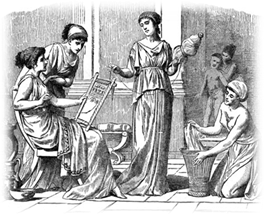 Harkening back to ancient Greek and Roman mythology for orientation in love brings us to the story of Venus and her lover Mars. Bruce Thornton, in his book, Eros: The Myth of Ancient Greek Sexuality, describes how the power of love brought the pleasures of sex as well as the curses of Eros-induced insanity, violence, disease, and chaos. The vanity of Aphrodite (Venus) and Helen of Troy resulted, we are told, in the carnage of the Trojan War. Back then, Cupid was not a cute, pudgy cherub, but a mischievous young man shooting real and painful arrows. We still hear the old refrain, “Love hurts.” Of course, human relations became more torturesome under the dominator arrangement of the first millennium BCE. Our history books hail ancient Greece as the cradle of democracy, winking at the fact that Athens was a slave state. In addition to the lower rungs of society laboring as slaves and servants, even upper-class women were confined to the husband’s or father’s house, could rarely own property, and could not vote. Female children could be sold into slavery by the head of the household, the father. Zeus, the Greek archetype of the Father, beat his wives, abducted his lovers, and raped the “objects” of his desire. It is noteworthy that under such a system, Aphrodite upheld a measure of dignity in her relationships. As the Greek pantheon developed, the gods gained more jurisdiction over the ever more disempowered goddesses. With the diminution of the Mother archetype, Aphrodite, as well as Athena, were said to be born without mothers. The Olympian deities, who were believed to be real by their worshippers, were the role models for the society at large.
Harkening back to ancient Greek and Roman mythology for orientation in love brings us to the story of Venus and her lover Mars. Bruce Thornton, in his book, Eros: The Myth of Ancient Greek Sexuality, describes how the power of love brought the pleasures of sex as well as the curses of Eros-induced insanity, violence, disease, and chaos. The vanity of Aphrodite (Venus) and Helen of Troy resulted, we are told, in the carnage of the Trojan War. Back then, Cupid was not a cute, pudgy cherub, but a mischievous young man shooting real and painful arrows. We still hear the old refrain, “Love hurts.” Of course, human relations became more torturesome under the dominator arrangement of the first millennium BCE. Our history books hail ancient Greece as the cradle of democracy, winking at the fact that Athens was a slave state. In addition to the lower rungs of society laboring as slaves and servants, even upper-class women were confined to the husband’s or father’s house, could rarely own property, and could not vote. Female children could be sold into slavery by the head of the household, the father. Zeus, the Greek archetype of the Father, beat his wives, abducted his lovers, and raped the “objects” of his desire. It is noteworthy that under such a system, Aphrodite upheld a measure of dignity in her relationships. As the Greek pantheon developed, the gods gained more jurisdiction over the ever more disempowered goddesses. With the diminution of the Mother archetype, Aphrodite, as well as Athena, were said to be born without mothers. The Olympian deities, who were believed to be real by their worshippers, were the role models for the society at large.
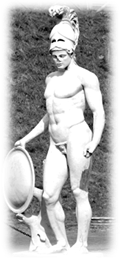
Ares/Mars, Roman
copy of Greek original
Among the many achievements of ancient Greece, we should include the dismemberment of the once omnipotent Great Goddess. So it is that our past becomes a “his-story” of the undermining of the mythic Feminine.
In the way that Aphrodite (Greek) became a more subdued Venus (Roman), and Ares (Greek) gained more universal appeal as Mars (Roman), a vibrant, pertinent mythos does evolve. The title of one of Campbell’s books makes this point: The Transformation of Myth through Time. In Venus and Her Lover, Mars is no longer leading others onto the battlefield with bloodthirsty intent, but now allows his warrior nature to fight the greatest battle of all: the struggle for the triumph of the true self, to ultimately realize the eternal Self. He willingly faces his ego and re-integrates his masculine and feminine aspects through determination, devotion, and unconditional love.
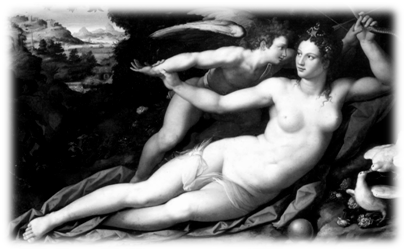
Venus and Cupid, by Alessandro Allori (1535-1607)
Venus is no longer so self-absorbed that her jealousy, anger, cruelty, and vanity dictate her actions. Her mastery of sensual love now broadens intospiritual love. Yet this is beyond the distinction drawn by Renaissance artists of the two kinds of love: amore vulgare, Earthly love experienced by the senses that tempts one into debauchery; and amore celeste, the noble, spiritual love that leads one to Heaven. Michelangelo portrayed the former as Cupid and the latter as Venus in the painting “Venus and Cupid”, a theme repeated by his contemporaries. Michelangelo and other Renaissance painters and poets molded ancient mythological themes according to Church dogma, which further divorced the sublime experience of love from the body.
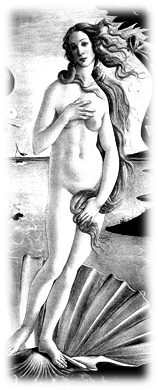
Birth of Venus, detail (1485)
by Sandro Botticelli
The new Venus reintegrates them. She is sensual. She has no need to demurely cover her nakedness, as in the universally recognized “Birth of Venus” by Botticelli. Her love of beauty pervades her dealings with Mars and all others. Naturally, Mars and Venus now meet in tantric relationship. Their love is honest, evolutionary, and at once physically pleasurable and spiritually transcendental.
Tantra, “the seventh yoga”, especially the tantric approach to sexuality, is coming to the fore in our time because it responds to the romantic questions and spiritual emptiness so many have in their love lives. With the ultimate goal of attaining enlightenment, the practices ofkundalini yoga, in addition to tantric strains of Hinduism, Taoism, and Buddhism, have interwoven many of their symbols, vocabulary, and practices. The concept of “Goddess” fleshes out the esoteric idea of a Feminine Principle, and the Hindu and Buddhist pantheon of goddesses and gods figures prominently in Tantra, as well as in Venus and Her Lover. Although strictly speaking only a force of Nature, Shakti appears as an Indian high priestess in the painting and as a cascading stream in the poem, and in further works, as her Triple Goddess manifestations of Kali, Lakshmi, and Saraswati. In these forms, we find ways to relate personally with the essential energies of the Universe and of ourselves. It is important, however, not to confuse the symbol with the archetypal idea. When Venus appears with her lovers Mars and Adonis (in “Son of Life”), we are prompted to consider the meaning of unconditional love, possessiveness, the cycles of Nature, the temporality of life, and the reality of death. When Pele and her lover (in “Pele and the Prince”) revel in sexual ecstasy, we witness the power of creation that love can ignite. In Venus and Her Lover, archetypes appear in human form to communicate soul truths, just as they did in ancient sculptures, seals, mosaics, paintings, theater, poetry, and song.
In God’s Image

Odin (depicted on 7th century Vendel helmet plate, Sweden)
As images of compassion and joy resonate more perceptibly within us, we can release our grip on the strange and sadistic ghosts lurking in our psyches. These ghosts hand us our scripts, whack us with guilt when we forget our lines, and pull the strings we grip so compulsively. It is a perverse drama our mythological puppeteers have us performing. In it, life and all Creation come from men alone – without women! Odin creates the Universe with his brothers Vili and Ve. God the Father makes Heaven, Earth, and all plants and creatures. Pan Ku hammers and chisels on Creation for 18,000 years.

Nagasaki, 1945
The world is arranged in a hierarchy, with God on top of the priests or divine-right kings (or prime ministers), who are over the elite men (or countries), who are over other men (or other countries), who are over women, children, and slaves. Rule is enforced by violence or the threat of it. Zeus and Thor wield thunderbolts. Yahweh/Jehovah/Allah (or their representatives) smite offenders and nonconformists with fire or floods or other means of mass destruction (witness, for example, Sodom, Gomorrah, and Hiroshima). The ability to dominate and destroy (spears, swords, crucifixes, guns, bombs) is glorified over the power to give birth and nurture (mothering, gardening, homemaking).
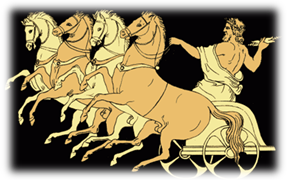
Zeus hurls his thunderbolts
In the journey of the Hero – the classic storyline – the man proves his bravery by killing his enemies or a monster (often a goddess symbol). Gilgamesh kills Ishtar’s bull, Zeus fries Typhon the serpent with his lightning, Herakles slays Hera’s serpents, the Nemean lion, the nine-headed Hydra, and others. In one chapter of the Bible (2 Samuel 8), King David and his army crush the Philistines, Ammonites, Moabites (killing two-thirds of them), Syrians (killing 22,000), Edomites(killing 18,000) and other pagan (i. e. Goddess- or Nature-worshipping) peoples. Heroic exploits may have been a necessary step in history for civilizations to establish themselves, but does the Hero’s exploitation serves us at our stage of evolution today?

David (1504)
by Michelangelo
Photo: David Gaya
 Michelangelo’s masterpiece sculpture exalts David’s battle with the Philistine Goliath. Lauded as a triumphantconqueror, King David is praised for his slaughter of tens of thousands of people (1 Samuel 18:6-7), his Hitleresque accomplishments apparently pleasing to the Man Upstairs (2 Samuel 5:10). King Arthur and his knights follow the sword Excalibur into battle, and fairy-tale knights slay fire-breathing dragons. Rambo massacres with his machine gun. Dirty Harry “makes his day” with the business end of a .44-Magnum (“guaranteed to blow your head clean off!”). James Bond annihilates his adversaries with deft coolness. Luke Skywalker slays the faceless storm troopers of the “Dark Side” with his light saber. Hollywood replays this brutal myth ad nauseum with progressively more graphic and gruesome body counts. We relate such stories to our children at bedtime and have them color pictures of Bible heroes in Sunday School. When our children get a little older, they themselves can practice their assassination skills via video games.
Michelangelo’s masterpiece sculpture exalts David’s battle with the Philistine Goliath. Lauded as a triumphantconqueror, King David is praised for his slaughter of tens of thousands of people (1 Samuel 18:6-7), his Hitleresque accomplishments apparently pleasing to the Man Upstairs (2 Samuel 5:10). King Arthur and his knights follow the sword Excalibur into battle, and fairy-tale knights slay fire-breathing dragons. Rambo massacres with his machine gun. Dirty Harry “makes his day” with the business end of a .44-Magnum (“guaranteed to blow your head clean off!”). James Bond annihilates his adversaries with deft coolness. Luke Skywalker slays the faceless storm troopers of the “Dark Side” with his light saber. Hollywood replays this brutal myth ad nauseum with progressively more graphic and gruesome body counts. We relate such stories to our children at bedtime and have them color pictures of Bible heroes in Sunday School. When our children get a little older, they themselves can practice their assassination skills via video games.
 The tough guy hero, well armored against even his own emotions, cannot risk losing control of this upside-down reality, and so must subjugate and denigrate women, and suppress anything feminine. During a dinner table conversation about this project, one of our relatives declared, in his booming masculine voice, “There ain’t nothin’ feminine about me!” In this way, a man can push into the shadows his own Goddess-given qualities of radiance, compassion, nurturance, introspection, or receptivity. A man so threatened can maintain his superiority only as long as Woman is held down in a position of inferiority. He approaches a love affair as a conquest. Here the myth manifests as pornography, rape, white slavery and forced prostitution, and the stoning of women for the slightest infraction against fundamentalist Islamic law.
The tough guy hero, well armored against even his own emotions, cannot risk losing control of this upside-down reality, and so must subjugate and denigrate women, and suppress anything feminine. During a dinner table conversation about this project, one of our relatives declared, in his booming masculine voice, “There ain’t nothin’ feminine about me!” In this way, a man can push into the shadows his own Goddess-given qualities of radiance, compassion, nurturance, introspection, or receptivity. A man so threatened can maintain his superiority only as long as Woman is held down in a position of inferiority. He approaches a love affair as a conquest. Here the myth manifests as pornography, rape, white slavery and forced prostitution, and the stoning of women for the slightest infraction against fundamentalist Islamic law.
Given that so many people were raised on stories of a god who apparently relished conquest and carnage, while in the same breath professed love and charity, it is no wonder we have a schizophrenic perception of love. The angry parent who beats his child with a strap while declaring, “I’m doing this because I love you,” can also rationalize killing and war while professing to believe in love and peace. The mythology he has internalized says it is OK to say one thing and do another, or somehow that loving and inflicting pain are consistent with one another.
Along with the mythic mindset comes efficient organization, clearly-defined roles in society, law and order, respect for authority, the work ethic, belief in a Higher Power – in other words, the glue that holds society together. Our focus here, however, is on its pathological aspects that have been handed down to us through our traditions, and how they could be reformed.
Much of our modern, technological society was built upon a Judeo-Christian mythological foundation inhabited by a misogynous, warmongering, intolerant deity. His followers were/are morally secure in their right to conquer evildoers, conquer Nature, conquer any who resist. What effect has such a moral code had on us? Take a look around. Myths may be society’s dreams, but they have resulted in a nightmare for the millions of women, children, and men who are living in hunger, poverty, and environmental degradation. Many of our fellow human beings wake up every morning to dodge bullets in war zones and pick through garbage in refugee camps. Our beliefs have teeth.
From the Earth Mother
Look deep into nature, and then you will understand everything better.
~ Albert Einstein
Originally, mythology arose from Nature. Our ancestors, living in moment-to-moment relationship with the forces of Nature, developed rituals to embody and empower that relationship. Native American braves, on the eve of the buffalo hunt, would role-play/invoke the archetypal quest through their dancing – with buffalo-headed dancers and hunter dancers – all the while requesting that the spirits of those involved grant success for the tribe. The ritual dance had a sense of reality because it was rooted in Nature. Modern religion, when it disconnects from Nature, makes its rituals according to dogma. Ceremonies are grounded in the mind. Useful are the rituals that allow us to travel the bridge between the natural and the supernatural (where our view stretches to the mythic horizon), and even more valuable are those that transcend Nature, our bodies, and our mental dogmas, to catapult us into the realms of the Eternal.
Myths can provide such a springboard, if we place them in historical context (their place in human evolution) before placing them in a personal context. Because our rational minds have proven myths to not be really real, we tend to dismiss what they bring to us as historical artifact at best. Venus and Her Lover proposes taking another look at mythology as the bearer of our culture . . . but not until we have fresh eyes.
The Rediscovery of Mythology
Without mysticism, it is not myth. Myth is not just stories. Myth lets youexperience it here.
~ Joseph Campbell
Myths come to us via a long and twisted road. We do not know about Isis and Osiris because an ancient Egyptian has personally told us about them. Nor can we blindly trust the many-times edited words of the apostles who wrote about Jesus Christ years after his death. Traditionally we have relied on scholars and artists.
For centuries the study of mythology was the domain of patriarchal high culture – not the best source for our concepts of Woman and Man, divine or otherwise. Then, out of the stratified society of Victorian England, a crack developed in the surface of classical interpretation. Sir James Frazer, in his classic opus The Golden Bough (1890), postulated that there was originally an Earth-centered matriarchy. Robert Graves, in his books, The White Goddess (1948) and The Greek Myths (1955), decried the shift from Goddess-based matriarchies to warrior-dominated patriarchies. Erich Neumann, a student of Carl Jung, elucidated the feminine archetype in his thick, illustrated book, The Great Mother (1955), in which he drew from many world mythologies.
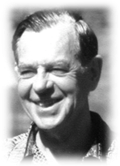
Mythologist Joseph Campell (1904-1987) Photo owner: Joan Halifax (Upaya)
Joseph Campbell’s lifetime of work [including The Hero with a Thousand Faces (1949) and the Masks of God series (1950’s-1960’s)] re-interpreted mythology incorporating 20th-century psychology, archaeology, and anthropology. Using his capacity for reason, he emphasized that the true power of myth was released when we read them as allegories, taking them in an “as if” context. Campbell related his fresh perspectives to a broad audience through television interviews with Bill Moyers (The Power of Myth, 1987).
The modern rediscovery of mythology unearthed and dusted off female archetypal figures and then began to extricate them from the male interpretation of their place in a dominator culture. Eco-feminist scholars asserted that early figures of the Great Mother did not come out of matriarchies per sé, but from egalitarian, partnership cultures. It was then only a happy leap to a glorification of our past. Perhaps the chill of clinical scientism (putting faith in science as ideology) could be warmed by the wisdom of the “noble savage”. Given the abuses of the Patriarchy, it is understandable that we might yearn for a simpler, more balanced time. What would it have been like to live in a goddess culture, to work the earth alongside men, to worship the Great Mother? The likely answer is that women would have been in arranged marriages, barefoot and pregnant, and that everyone in the tribe submitted their individuality (if such a self-concept existed) to the good of the clan, in the name of survival. Instead of equal rights, no individual rights: just surrender to the group. The tribal paradigm, with its animist beliefs and superstitions, with its honor of the Divine Feminine, is our common heritage, and we must distinguish what gems we wish to mine from its mountain of culture.

Archaeologist Marija Gimbutas (1921-1994)
Photo: Michael Everson
Venus, as archetype, has always been there, but our perception of her has changed. She has become more relevant to us, notably through the work of archaeologist Marija Gimbutas (The Goddesses and Gods of Old Europe, 1974), artist Merlin Stone (When God Was a Woman, 1976), psychologist Jean Shinoda Bolen (Goddesses in Everywoman, 1984), and scholar Riane Eisler (The Chalice and the Blade, 1987). Eco-feminism hauled up patriarchal myths before the scrutiny of modern standards of women’s rights, making them available for more empowering interpretations. C. Kerényi, a classicist who loved re-telling mythical stories, states in Essays on a Science of Mythology, “If we want to promote a real knowledge of mythology, we must not appeal at the outset to theoretical considerations and judgments. Neither should we talk overmuch of ‘sources’. The water must be fetched and drunk fresh from the spring if it is to flow through us and quicken our hidden mythological talents.” [Essays on a Science of Mythology, p.1]

Ithyphallic Pan, pursuing tree nymph,
tile mosaic from Pompeii,
1st century CE
We all have these talents. How to develop them? Mythological characters may point the way at truth, but we must find it for ourselves. Indeed, beyond the obvious correlation of Mars with Man and Venus with Woman, they invite us to experience the male and female aspects of the androgynous soul. Whether we participate in a communion ritual or a pilgrimage or a prayer of thanksgiving, these symbolic actions give us practice in how to act authentically in the manifest world, in balance and harmony with the forces of the Kosmos. We may think ourselves modern and clever to toss out a baptism ritual or a goat-foot god, but if we at the same time cease personal transformation and acceptance of grace (symbolized by baptism) or deny our wild, animal aspects (symbolized by the God Pan), then we rob ourselves of the tools we need to live life fully. Mythology points at unseen forces, nudging us to know the unknowable – the Great Void, Divine Order, Beyond the Beyond – from whence springs Life.
By personally identifying with the myth of a hero, a goddess, or a lover, not only can we learn from their story, we can peer into different facets of reality and deal with them directly. When our lives venture into a deep, dark forest, we may catch sight of monsters lurking in the shadows (fears or societal conditioning we must overcome, for example) as well as sparkly faeries (allies, synchronicities) who bestow magic charms (lessons, empowering techniques) along the way. We can gain access to the vast sea of human experience from which these stories come. And our ego-driven dilemmas become less confusing when seen against the backdrop of our mythological legacies. Jean Houston, in her book, A Mythic Life, says, “Working with myth and archetype, we discover that we are characters in the drama of the anima mundi, the soul of the world. In this discovery we push the boundaries of our own human stories and gain the courage to live mythically and to help heal our world.” [ Houston, Jean, A Mythic Life, p.99-100]
Healing our world is surfacing as Job #1, as the environment, personal alienation, social structures, and moral degradation all clamor for attention. With the death of species and ecosystems, and the disintegration of society, it seems like a time of endings . . . which, from a mythic viewpoint, means the pause before new beginnings. As Michael Meade states in The World Behind the World – Living at the Ends of Time, “When it seems that the end is near it is important to have a mythic sense for things and a story-mind; not a fantasy to escape with, but enough imagination to help hold the ends and beginnings together.”
[http://www.facebook.com/Michae.J.Meade]
The Ascent
Make your god transparent to the transcendent, and it doesn’t matter what his name is.
~ Joseph Campbell
We are all descendants of tribes. Becoming reacquainted with our magic ancestry through the experience of nature mysticism grounds us in the reality of the four elements. This material world is made of earth, air, fire, and water, which can be approached through Native American vision quest; shamanic journeying through ethnobotanicals (“magic plants”); communion with rivers, mountains, volcanoes, the sun, and other natural phenomena; and worship with totems, amulets, sacred places, power animals, and magic spells. Nature mysticism embeds us in this physical world and its play of forces, while allowing Spirit to touch us in its primal form.
Deity mysticism legitimizes a personal relationship with the Divine. Through our devotion to a god or goddess, we can imagine the Great Spirit in human form, someone with whom we may discuss our hope and despair, ask for guidance, or share comfort. To this Divine Being we pray and make offerings (“How great Thou art!”). Through deity mysticism, we place ourselves in the great cradle of the collective unconscious, which is woven not only of the unbroken filaments of the tribes’ relationship with Nature for several 100,000 years, but also with threads of Culture, most notably the rich mythologies of the last 10,000 years of human imagination and striving.
Those established, we may widen our identity yet again – beyond physical Nature and human Culture – to the Spirit that created (and continues to create) the manifest realm as we know it. It is, in a sense, lifting off of Earth. We can call it Ascent.
The higher you climb, the farther you can see. A necessary stop on this horizon-expanding journey is the Witness. Called the “I behind the I”, or the “I” behind our eyes, or the formless seer, the One we were before we chose to incarnate is the One we become when we die. Much meditation practice involves becoming still enough to observe sounds around us, thoughts, feelings, physical sensations – everything that arises in our awareness – that tell us we are not that. As Witness, we can observe them as separate from us. We are something else – something deeper, or higher, or more encompassing. Taking this step back in perspective, Hindus and Buddhists identified the manifest world as illusory: samsara. Thus is the practice of formless mysticism. Ultimately we get over our case of mistaken identity and realize ourselves as the One, the All That Is, the Great Spirit, the Absolute Self. Like the Zen monk said to the hot dog vendor, “Make me One with everything!”
In nondual mysticism, all definitions drop away, and we are nothing but “clear light”, the union of form and the formless. This is the ultimate realization of virtually all the world’s spiritual traditions, described as satchitananda (Hinduism), Supermind (Sri Aurobindo), turiyatita, sahaja, and Brahman-Atman (Vedanta), Ein Sof (Jewish Kabbalah), tzu-jan (Taoism), One Taste and Buddhahood (Buddhism), zat (Muslim Sufism), and illumination (Christianity).
Since the essence of who we are does not have to be born to exist, it does not have to die, either. It exists dependent on nothing, forever and ever. Fear drops completely. What could we possibly be afraid of? With this enlightenment, full of love, we experience total freedom.
Dwelling in Emptiness, in the realm of the Formless, in nirvana, in bliss for all eternity . . . how could you follow that up? Apparently, we decided that we could follow it up with the perfect activity for an Infinite Creator: Creation.
The Descent
We decide to create, and then to play in our creations. We can descend into the world of form. As the Divine Absolute, we can perform all the parts (though it may require that the actors have amnesia, to keep it interesting . . . dramatic, even!) and create to our hearts’ content. We play the sport of life. Hindus call this lila.
The desire for transcendence through Ascent and the desire to embrace through Descent are within each of us. God the Father in Heaven and Shiva as pure consciousness or the Zero Point Energy Field represent the Masculine, whereas the Mother Goddess and Shakti as force of creation in the manifest world represent the Feminine. From their sexual union, their hieros gamos, Shakti gives birth to the child. Father-Mother-Child is a widespread archetype: the Holy Trinity as Family. The Divine Child is us. Carrying our father’s and mother’s lineages within us, we have the opportunity to fully explore our Earthly playground, and kick up our heels as we frolic in lila.
It is in this spirit that we the authors suggest re-inhabiting the world of form, taking part in nature mysticism, deity mysticism, or formless and nondual mysticism, as suits our individual tastes. The Buddha did point out: “Nirvana and samsara are not two.” Which we call it at any moment depends upon our consciousness.
The previous steps of detaching from the world of appearances may trigger a Dark Night of the Soul, a lonely albeit necessary passage to a dawn of liberation. Once our mythic mindset has undergone a period of atheism – of rejecting the gods and goddesses as literally and exclusively real, with power over us – we can then invite them into our lila. We can interact with them not as the One and Only but as expressions of Spirit.
The Buddhist master Seigen Ishin is reputed to have related his process in this way:
Before studying Zen – there are mountains and rivers
While studying Zen – there are no mountains, no rivers
After studying Zen – there are mountains and rivers
Jay Michaelson, in his book, Everything is God: The Radical Path of Nondual Judaism,describes how he enjoys practicing his religion, even though he knows that “God” is just a concept. “Yes, every concept is a mask, and all masks are illusory, but many are helpful in translating nonsense into sense. And since all masks are illusory, all masks are permitted.” [Everything is God: The Radical Path of Nondual Judaism, p.105]
Michaelson describes his experience with Emptiness when he says, “If you have an image with limits, prepare to surrender it. Thus, gradually, reflection and discernment lead to a radical letting go, a total surrender which melts our idols into light. God becomes the All, and the Nothing, and becomes the One looking through your eyes right now.” [Everything is God: The Radical Path of Nondual Judaism, p.104]
From the world’s mythologies and tribal traditions, Venus and Her Lover takes the characters and natural forces that have in the past enchanted humanity, and recasts them into roles more resonant with us today. After all, they are old friends. Akin to our favorite comfy sweater we put on in freezing weather, we can don a divine personage before steering our ship through the hurricane. While we face planetary crises, we can invoke them to see us through our current transition. Just as the bumper sticker succinctly reminds us, “Evolve or Die”, we must evolve. Venus and Her Loverintroduces familiar faces into a novel context, so we may all go through evolution together.
Transcend and Include
Don’t want to take up a contemplative practice? That is fine, but then it becomes all the more important to place mythology within a framework that permits coexistence with rational debunking and pluralistic acceptance of other beliefs. We live in a modern age based on reason and human rights. We do not have to reject all of science or rational thought to be able to embrace parts of mythology, nor vice versa. In our hands we carry a medicine bag containing precious stories, symbols, and rituals from our past; we can transcend the smaller worldviews that created them while still including treasured artifacts from our walkabout on Earth. Indeed the contents of our collective medicine bag could minister to our shattered human family.
Do we all trace a bloodline to Adam and Eve? Did Jesus actually walk on water? Was Lao Tzu 900 years old at birth? Did Mohammed in fact travel from Mecca on a winged horse? Did Shiva reduce Kama to ashes with a glance from his third eye? Is it worth going to war over the validity of these characters??
Focusing on the dogmatic and mythological details of different religious traditions serves to lead the worshipper astray from their essential truths, which were established, we must remember, by prophets, saints, and avatars who themselves diligently kept spiritual practices. They focused less on spewing dogma and more on participating in a method to realization. Jesus fasted for 40 days and 40 nights, Mohammed retreated to a cave to meditate, and the Buddha sat in meditative absorption despite great hardship. Other religious founders followed a similar process. Tantra, as a time-tested yogic practice, can also reveal eternal truths. Short of committing to a yoga or devotional path, then, we must grasp mythological trappings with a light touch.
The art and poetry of Venus and Her Lover may change the costumes of traditional deities on the stage of lila, but aims to disrobe them entirely. Stripped naked, they all become the Divine Beloved, beckoning us to peer past appearances to realize their – and our – true identity as the One.
Goddess of Love and the God of War
These things never happened, but always are . . .
the myth is in accord with the cosmos.
~ Sallust

Venus and Mars in “Center Stage”
by JG Bertrand (detail)
Venus and Mars are re-inventing their mythic story through our artistic efforts, James and I humbly believe, because men and women are, at this time, bridging the gulf that separates them. Yin and yang energies at play in our world of duality have been painfully out of balance. More and more people are rejecting the scripts they were handed by the dominator puppeteers – as evidenced by feminism and the growing men’s movement – and they begin to discover their own stories, their own true expressions of themselves. Naturally then, our myths – our cultural story – must change. We all have a part to play. It is our collective idea of love that fashions a new Venus, and our collective idea of power that forges a new Mars.
At the same time, it is the ideals of the Divine Feminine and the Divine Masculine that pull us toward every greater expressions of ourselves (and our Self) . . . not only concepts held collectively, but new ways of being that have yet to come forth. It is through us that Spirit can consciously emerge on Earth.
Riane Eisler says in Sacred Pleasure :
“There is today so much interest in both very ancient and very new myths. This is not just, as we are sometimes told, a ‘New Age’ fad. It stems from the recognition that many of our myths are not only inappropriate for our rapidly changing world but misleading about human possibilities. Most important, it stems from the growing consciousness that how we image our personal and social paths can profoundly affect both our own lives and those of others.” [Sacred Pleasure, p.372-373]
The Venus and Mars that have materialized before our eyes through our art were born of our tantric love partnership during an era when a new model of sustainable relationship and balance is emerging. Our artistic portrayals were made possible, first and foremost, because of our willingness, our openness to archetypal forces. The characters seem to have matured symbolically and physically: the paintings and poetry depict a couple that has left behind the fatuous illusions of adolescence and are, in fact, middle-aged. With eyes wide open to the challenges of the man-woman union, Mars and Venus explore the infinite splendors of what sacred love can be. These explorations bear offspring: a modernized myth for a new age.

